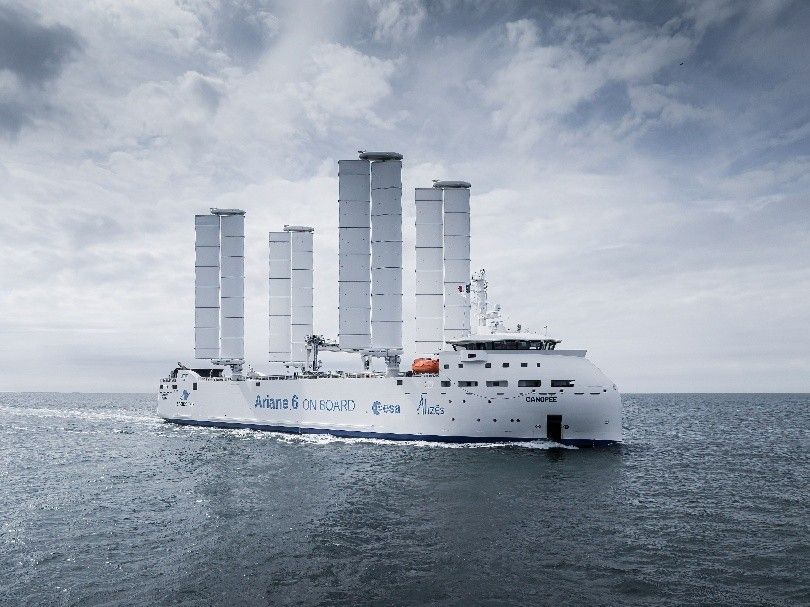FFplus Interview with Kevin Charpot, Oceanwings

In this interview, we speak with Kevin Charpot, CFD and wind propulsion engineer at OceanWings, a French SME revolutionising the shipping industry with their advanced wingsail technology. Kevin specialises in the aerodynamic design and optimisation of wingsail systems, and leads the development of high-fidelity simulation workflows using open-source tools and HPC.
Kevin explained how OceanWings is helping decarbonise maritime transport by combining engineering excellence with digital innovation — from overcoming complex aerodynamic challenges to integrating scalable HPC-powered simulations into their R&D pipeline. Kevin also shares insights from their successful participation in the FF4EuroHPC Business Experiment, and offers practical advice for SMEs and startups looking to adopt HPC and AI.

Kevin Charpot, CFD and wind propulsion engineer at OceanWings
Copyrights: OceanWings
Welcome, Kevin! It's a pleasure to have you here. Let’s dive right in. Can you briefly introduce OceanWings and explain what sets your Wind Assisted Propulsion Systems (WAPS) apart in the maritime decarbonisation landscape? How does your team contribute to innovation in the shipping industry?
OceanWings is a French SME that designs and delivers Oceanwings®, a patented articulated wingsail system for wind-assisted propulsion. Unlike soft sails or simple wings, our system uses a two-element airfoil — a main wing and a flap — controlled by an onboard system that continuously adjusts the sail for optimal aerodynamic performance. This enables precise aerodynamic trimming and maximises thrust efficiency under changing wind conditions.
What sets us apart is that Oceanwings® is designed for real-world shipping conditions. It’s automated, robust, and tailored for large commercial vessels. Our team brings together naval architecture, aerodynamics, and systems engineering expertise to offer a scalable, industrial-grade solution for reducing emissions in maritime transport. Innovation for us means not only better performance, but also integration into the operational and economic reality of shipping.
That’s a great overview — the combination of engineering precision and real-world application really sets OceanWings apart. What are the most complex engineering problems you face when designing and testing WAPS, and how do you address them using High-Performance Computing (HPC) or Artificial Intelligence (AI)?
One of the key challenges is understanding and optimising the aerodynamic performance of the wingsail under the complex wind environments encountered at sea. Each vessel interacts differently with the wind depending on its shape, speed, and superstructure. The number of design variables — trim angles, flap angle, wing positions — leads to a massive solution space.
To address this, we use HPC-based CFD simulations to evaluate the aerodynamic behaviour of different configurations. These simulations give us detailed insights into flow fields, pressure distributions, and thrust generation, which would be extremely difficult to assess with traditional tools or wind tunnel tests alone. HPC allows us to explore this vast design space efficiently and with high accuracy.
It’s fascinating to hear how HPC can turn what used to be a bottleneck into a real design advantage. How do OceanWings engineers integrate High-Performance Computing HPC (and/or Artificial Intelligence) into engineering and R&D workflows? Could you share some key use cases where HPC plays a critical role?
HPC is fully integrated into our design and analysis processes. We’ve built an automated workflow using OpenFOAM that connects directly to remote HPC clusters. Engineers can define a set of configurations, and the system takes care of mesh generation, solver setup, execution, and post-processing — all in parallel. The pipeline connects directly to our optimisation environment, which uses Bayesian algorithms to propose new wing trim configurations and learn from previous results.
One of the most important use cases is the parametric analysis of aerodynamic trim. For a single vessel, we might run thousands of simulations across different wind angles and wing settings to determine the optimal setup. HPC gives us the capability to complete such campaigns in days instead of months, which is essential for both design timelines and customer responsiveness.
Let's now talk a bit about your experience with the participation in the FF4EuroHPC Business Experiment. Could you share some insights into that experience? How valuable was the opportunity for your company in terms of innovation, development, and collaboration with other organisations?
The FF4EuroHPC experiment was a turning point for us. It allowed us to move from an ad hoc, manual simulation process to a scalable, robust CFD-HPC toolchain. The collaboration with PoliMi, CINECA, ToolsPole, and USI brought together deep technical expertise across domains — CFD modelling, software automation, HPC infrastructure, and optimisation science.
Beyond the technical outcome, it introduced us to a community of European innovators. It gave us visibility, strengthened our credibility, and opened up new ideas for how HPC and AI could support our roadmap. It also proved that even SMEs can successfully integrate HPC into their workflows with the right support.
That’s a powerful message for other SMEs out there — collaboration and support can accelerate transformation. In your experiment, your team—supported by project partners—developed a cutting-edge wind propulsion system for maritime transport, known as OceanWings. What business benefits did you gain from this development, and how has the experience continued to support your company after the experiment concluded?
Thanks to the experiment, we now have a simulation framework that supports faster design cycles, higher accuracy, and lower cost. It gives us a competitive advantage — we can customise Oceanwings® configurations for each customer’s ship with greater confidence and speed. This has led to a more agile commercial offering and higher customer satisfaction. Post-project, we’ve continued to expand the workflow, refine the optimisation algorithms, and integrate the results into our real-time control software. The groundwork laid during FF4EuroHPC is now embedded in our day-to-day R&D operations — it's not a prototype, it’s production-ready.
For SMEs and startups exploring HPC and AI for innovation, what advice would you give? Are there specific challenges they should anticipate or best practices to follow?
First, don’t be intimidated — HPC is more accessible than ever. Focus on automation from day one. Manually running simulations won’t scale, and the value of HPC only becomes apparent when paired with efficient workflows. Second, find the right partners. Collaboration with HPC centres or academic institutions can accelerate adoption and de-risk development. And third, be very clear about your business goals. Use HPC and AI not just to make things “faster” or “smarter,” but to solve a real bottleneck — whether it’s simulation time, product customisation, or embedded intelligence. Lastly, invest in upskilling your team — even basic scripting and parallelisation knowledge will go a long way in maximising the benefits of HPC and AI.
That’s excellent advice, Kevin — practical and encouraging.
Thank you so much for this insightful interview. It was a real pleasure having you with us, and we wish you and OceanWings continued success in leading the charge for greener shipping through innovation.
Learn more about the success story HPC-based Design of Wind Assisted Propulsion Technology here.
